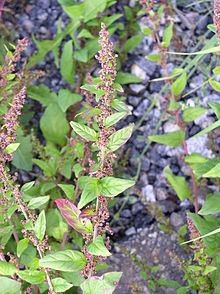Scientific name Lipandra polysperma Rank Species | Genus LipandraMoq. Higher classification Lipandra | |
 | ||
Similar Oxybasis glauca, Oxybasis rubra, Chenopodium ficifolium, Nettle‑leaved Goosefoot, Oxybasis chenopodioides | ||
Many seed goosefoot lipandra polysperma 2013 08 04
Lipandra polysperma (Syn. Chenopodium polyspermum), common name manyseed goosefoot, is the only species of the monotypic plant genus Lipandra from the subfamily Chenopodioideae in the Amaranthaceae family.
Contents
- Many seed goosefoot lipandra polysperma 2013 08 04
- Korrelganzenvoet lipandra polysperma 2016 09 15
- Description
- Distribution
- Systematics
- References
Korrelganzenvoet lipandra polysperma 2016 09 15
Description
Lipandra polysperma is a non-aromatic, glabrous annual herb. The stems grow erect to ascending or prostrate and are branched with usually alternate, basally sometimes nearly opposite branches. The alternate leaves consist of a petiole and a simple blade. The leaf blade is thin, ovate-elliptic, with entire margins.
The inflorescences consist of loose dichasia in the axils of leaf-like bracts, sometimes of more condensed glomerules of flowers arranged spicately. The flowers are bisexual or pistillate, with (4-) 5 nearly free perianth segments, 1-3 (-5) stamens and an ovary with 2 stigmas.
In fruit, perianth segments remain unchanged. The fruit has a membranous pericarp, which is free from the seed. The horizontally orientated seeds are compressed-globose. The brown to blackish seed coat is undulately striate.
Distribution
Lipandra polysperma is distributed in most regions of Europe and in temperate Asia. It is widely naturalized elsewhere, as in North America.
Systematics
The species was first described in 1753 by Carolus Linnaeus as Chenopodium polyspermum in Species Plantarum. After phylogenetic research, Fuentes-Bazan et al. (2012) separated this species from genus Chenopodium that would otherwise have been polyphyletic. The genus Lipandra was first described by Alfred Moquin-Tandon in 1840 (in Chenopodearum monographica enumeratio, p. 19.), replacing an older illegitimate name: Christian Friedrich Lessing's genus Oligandra (1835, not the Asteraceae genus Oligandra from 1832) had only one species, Oligandra atriplicoides, that was soon considered identical with Chenopodium polyspermum.
Lipandra polysperma belongs to the same tribe as Chenopodium, Tribus Atripliceae.
Synonyms of genus Lipandra Moq.:
